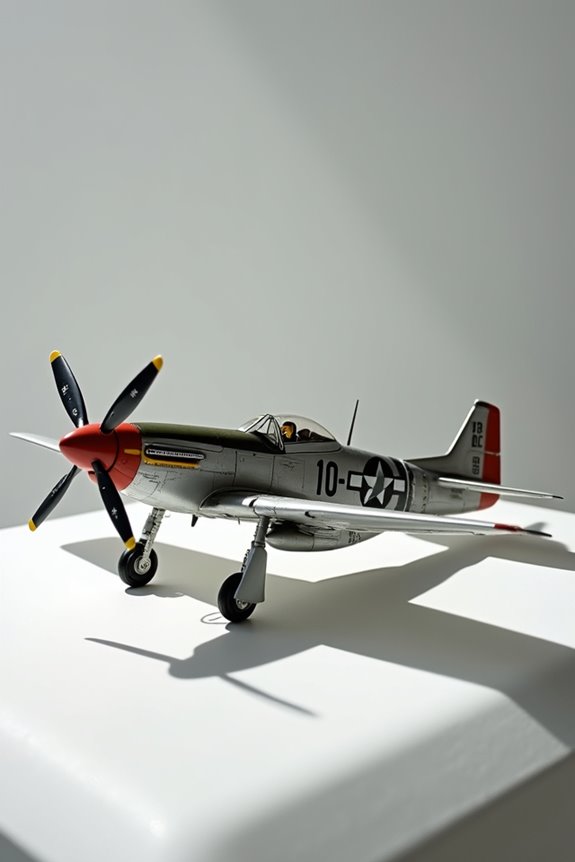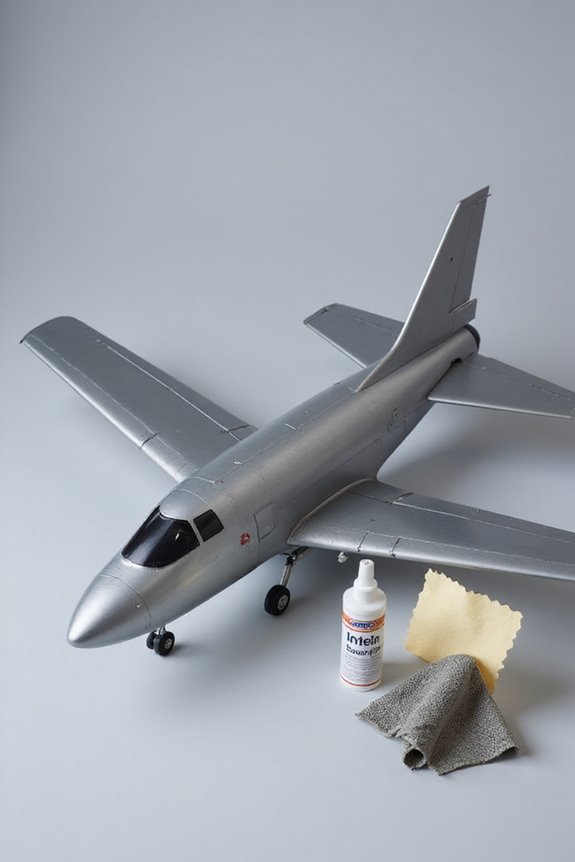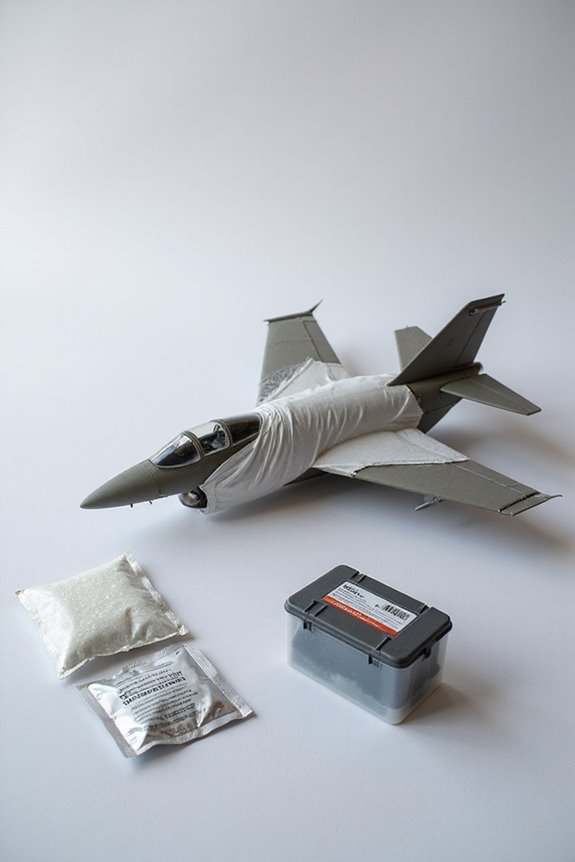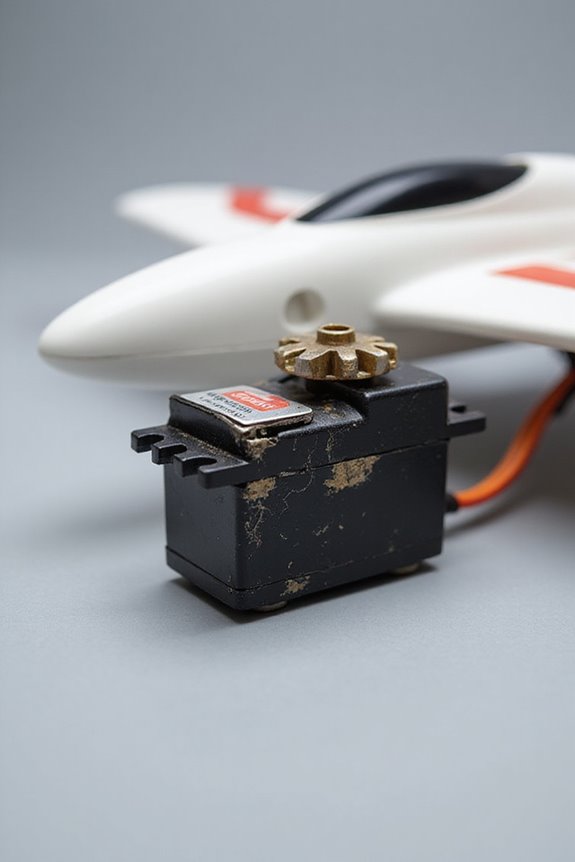To store our model aircraft long-term, we should start with rigid, impact-resistant containers—think hard-shell cases rather than flimsy cardboard. Keeping them in a climate-controlled area between 55°F and 85°F with 40-60% humidity is key. Let’s not forget to clean our models and check for any cracks or loose joints regularly. And remember, a well-organized hangar makes access a breeze! Stick around; we’ll share more tips to keep our models in top shape.
Key Takeaways
- Use rigid, impact-resistant containers and avoid cardboard for long-term storage to protect against physical damage.
- Maintain a storage climate of 55°F to 85°F with humidity levels around 40-60% to prevent warping and mold.
- Clean models thoroughly before storage, lubricate moving parts, and monitor battery conditions for optimal maintenance.
- Implement a clear labeling system and modular racks to organize models and accessories for easy access and efficient storage.
- Protect models with acid-free tissue or muslin, and ensure proper handling training to minimize physical damage during storage.
Proper Packaging and Container Selection
When it comes to long-term storage of model aircraft, selecting the right packaging can be a game changer. We should go for rigid, impact-resistant container types like hard-shell cases. Cardboard isn’t our friend for long periods. These smart packaging materials can save our beloved models from damage!
Inside, let’s use soft padding like high-density foam or bubble wrap. We want our aircraft snug but not suffocated! Remember, labeling is key; a simple tag can save us from a model mix-up.
Positioning’s essential too—let’s store our aircraft flat to avoid warping. This isn’t just protective; it’s protective, ensuring that our masterpieces stay in top shape for the next flight. Additionally, using a multi-layer storage solution can help maximize space efficiency while keeping your models safe and organized. So, let’s pack smart and keep those models happy!
Climate and Environmental Controls
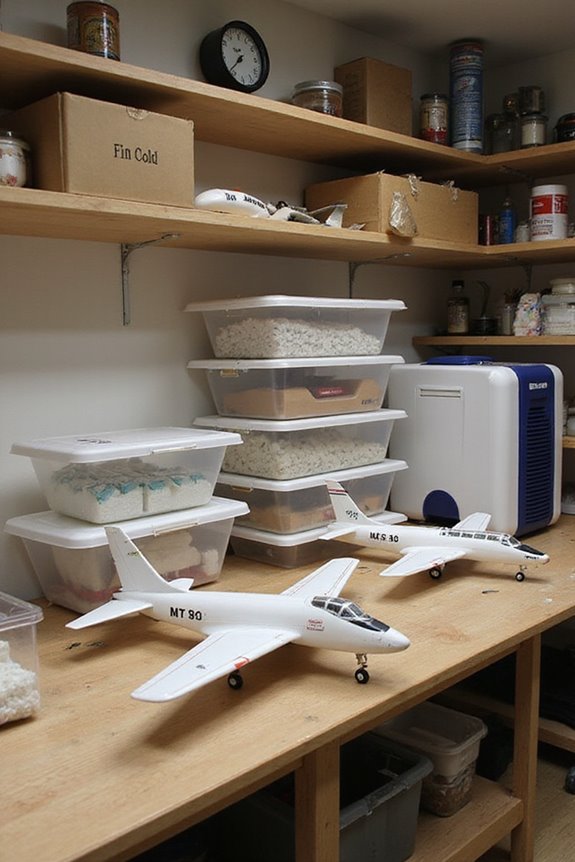
To keep our model aircraft in tip-top shape, we have to pay attention to climate and environmental controls. First up, temperature management! The sweet spot for storage is between 55°F and 85°F. Any higher, and our beloved balsa wood could warp like a pretzel. Low temps can make the materials brittle, which isn’t great either.
Next, humidity regulation is key. We want to keep it around 40-60% to prevent warping and mold. Excess moisture can turn our aircraft into soggy messes, so using dehumidifiers or silica packs is smart.
Let’s also avoid those dank basements—trust us, our airplanes deserve better. By managing temperature and humidity, we’ll keep our models safe and sound, just like a cozy airplane hug! Additionally, ensuring advanced stabilization technology is in good condition can help maintain the aircraft’s performance over time.
Long-Term Maintenance Procedures
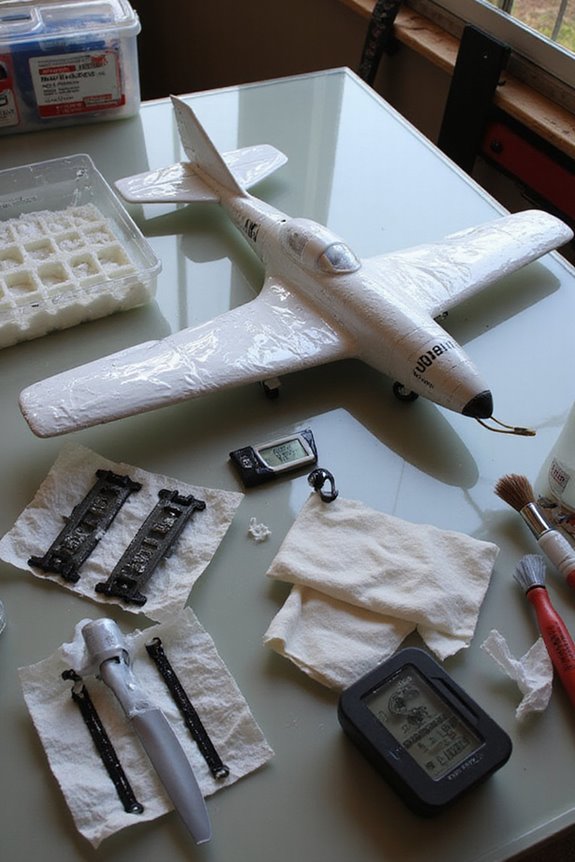
Now that we’ve got the climate covered, it’s time to get down to the nitty-gritty of long-term maintenance procedures. First, let’s clean our models thoroughly. We can use soft brushes and compressed air to banish dust and debris. Don’t forget those electrical contacts—clean them with isopropyl alcohol to avoid corrosion.
Next, let’s talk lubrication methods. A drop of light machine oil on moving parts does wonders. Just keep it light—we don’t want it attracting more dust! Make sure our batteries are safely removed and monitored during storage. Regularly check for cracks or loose joints in our airframes; a stitch in time saves nine, right? Recording our maintenance steps can also keep us organized for future fun! Additionally, having a well-rounded tool selection is crucial for effective maintenance and repairs.
Storage Organization and Accessibility
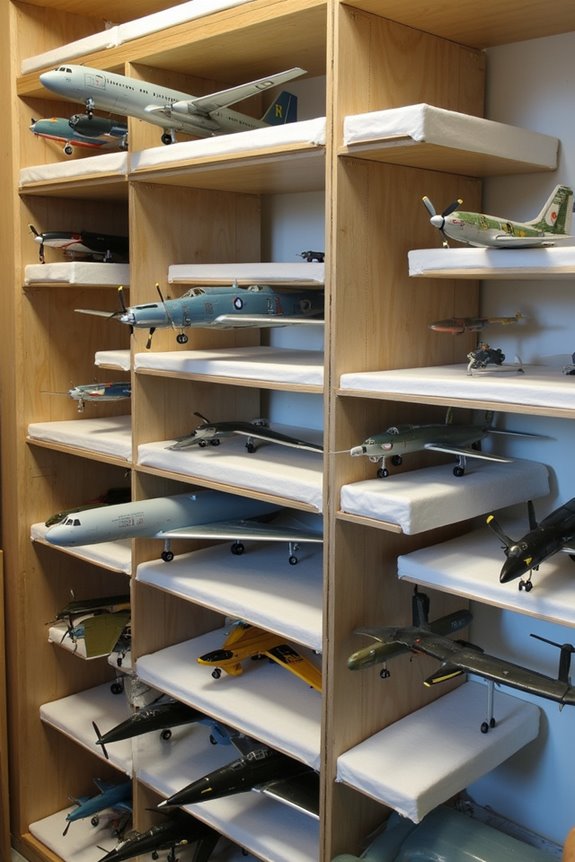
Storing our model aircraft isn’t just about shoving them in a corner; it’s an art form! To keep things accessible, we should use a good labeling system. Assigning clear labels to each model helps us spot what we need in a flash.
Let’s also get creative with modular racks. These adjustable systems let us stagger our aircraft, maximizing vertical space while keeping our workspace tidy. We can even group planes by how often we fly them, so favorites are always within reach. Additionally, utilizing multi-tiered designs can enhance our storage efficiency and showcase our collection beautifully.
Remember to organize parts and accessories in labeled containers nearby. Efficient storage will bring out our inner organizational guru and keep our models ready for action. Plus, who doesn’t enjoy a well-ordered hangar?
Protection Against Physical Damage
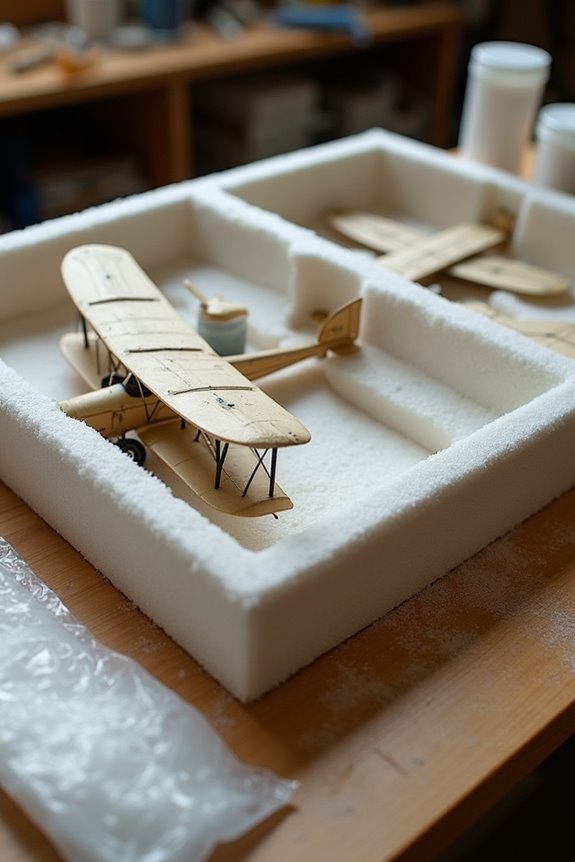
After we’ve organized our model aircraft for easy access, it’s time to focus on protecting them from physical damage. We need solid protective measures in place to keep our models safe. Using hard-shell cases offers excellent impact resistance, safeguarding against bumps or drops—no one wants a tragic crash during storage!
Don’t forget to wrap our models in acid-free tissue or muslin. It keeps dust away and protects those delicate surfaces. Storing them off the ground? That’s a must! It prevents pests and moisture from wreaking havoc. Additionally, consider high-quality propellers that are less likely to suffer damage during storage and handling.
Plus, proper handling is essential. When we move our models, let’s avoid careless mistakes and train everyone involved. Remember, our beloved aircraft deserve more than just a quick toss into a closet!
Frequently Asked Questions
How Often Should I Inspect My Model Aircraft While in Storage?
We should inspect our model aircraft every 8 weeks during storage, adjusting for storage duration and conditions. Light checks monthly can help us catch early signs of deterioration and maintain airworthiness.
Can I Store Different Types of Models Together?
In our garden of models, we understand that variety brings beauty, but model compatibility’s essential. Storing different materials together can lead to unseen storms; let’s choose our storage materials wisely to nurture each treasure.
What Should I Do if I Find Pests in My Storage Area?
If we find pests in our storage area, we should promptly implement pest prevention measures, thoroughly clean, and utilize effective storage solutions. We’ll guarantee our models are safe and monitor for any future infestations.
Is It Safe to Use Plastic Storage Bins for Models?
We think plastic bins are great for model preservation. Their durability protects against impacts and moisture. For ideal care, let’s follow some model preservation tips, ensuring our models stay safe and in pristine condition.
How Can I Protect My Models From Humidity Without a Dehumidifier?
To protect our models from humidity without a dehumidifier, we can use moisture barriers and humidity absorbers like silica gel. These methods create a controlled environment, preserving our cherished aircraft safely for the long term.

